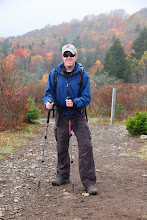"Saving Our Children From Nature-Deficit Disorder"
 Algonquin Books of Chapel Hill
Algonquin Books of Chapel HillCopyright 2005, 2008
316 pages
In his highly esteemed discourse on "nature deficit disorder," a term of his own invention, Richard Louv inspires a national movement. His thesis is straightforward: today's generation is nature starved, dependent on technology and driven behind closed doors, which has and will continue to cause great challenges for America and the whole world. Louv writes:
...Healing the broken bond between our young and nature [is] in our self-interest, not only because aesthetics or justice demands it, but also because our mental, physical, and spiritual health depends upon it. The health of the earth is at stake as well. How the young respond to nature, and how they raise their own children, will shape the configurations and conditions of our cities, homes - our daily lives. (3)Louv brings light to a serious issue that has been slowly brewing for several decades, exploding in most recent years with the increasing popularity of computers, cell phones, and iPods. Children are spending less time outside and more time glued to televisions and video games. In fact, many children seem entirely unaware of the wonders surrounding them. The outdoors is a scary place where unpredictable things happen, and children are encouraged to stay away. Louv expands on this premise in his book, discussing the 'fear element,' that plagues many parents who mean best for their children but limit their full potential for growth. At times it seems like an uphill battle. Louv reveals this staggering statistic:
...The Charlotte, North Carolina, region lost 20 percent of its forest cover over the past two decades; between 1982 and 2002, the state lost farmland and forests at the rate of 383 acres a day. The U.S. Department of Agriculture projects forests declining from 767,000 acres in 1982 to 377,000 in 2022. Amazingly, developed land in North Carolina increased at a rate twice that of the state's population growth. (30)Where, then, are children supposed to play in the outdoors? How can young peoples' senses develop if they are not in tune with the outdoor world? A direct consequence of nature's absence is the stunted growth of the visual and auditory senses. Physical and emotional health are also directly influenced by positive nature experiences. Louv writes, "...New studies suggest that exposure to nature may reduce the symptoms of Attention Deficit Hyperactivity Disorder, and that it can improve all children's cognitive abilities and resistance to negative stresses and depression" (35). With more antidepressants being prescribed to young people every day, this statement couldn't be more important. Ultimately, Louv claims the costs of Nature Deficit Disorder are severe: "diminished use of the senses, attention difficulties, and higher rates of physical and emotional illnesses" (36).
At 316 pages, "Last Child in the Woods" is a long book, but an engaging piece of work that has inspired national change, an entire movement to reclaim the outdoors for the American child. At book's end, Louv offers guidance to parents and educators, providing lists with creative ideas to engage children with nature. Many schools across the country are now incorporating Louv's ideas into their curriculum, developing "outdoor programs" and implementing outdoor classes. For example, Forsyth Country Day School in Lewisville, NC, has designed its own "Green Initiative" and offers a corresponding elective class for high school students in response to the nature movement.
For his work, Richard Louv was awarded the 2008 Audubon Medal. In the same year, he updated his book with new facts, educator guides, and a reassessment of the state of Nature Deficit Disorder in America.










I've been meaning to read this. I never really thought about it, but I was lucky enough to have an outdoor experience as a child. My family's hunting cabin was surrounded by all kinds of nature and the neighbors didn't mind kids crossing their yards. More and more, contiguous open space is being eliminate and kids don't get those opportunities. Thankfully awareness is on the rise and municipalities are also working on conservation by design efforts to preserve contiguous open space.
ReplyDelete